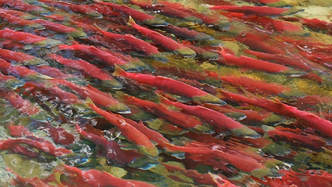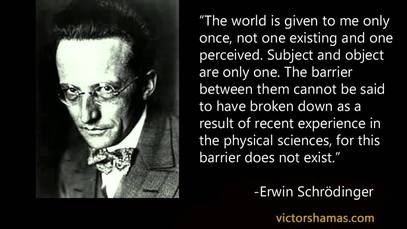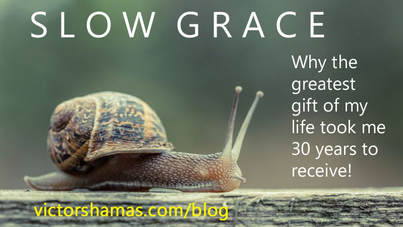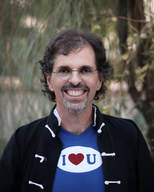 During a recent visit to Alaska, I had the privilege of witnessing the incredible spectacle of the salmon run. Every year, millions of salmon make their ways to local rivers and then head upstream to spawn. The sheer determination with which they overcome every imaginable obstacle is nothing short of awe-inspiring. Those that make it have to get past eagles, grizzlies, humans, and other predators. They push through relentlessly, even though their journey ends in their demise. Once the salmon have spawned, they die. This time of year, Alaska’s river beds become a mass graveyard where staggering numbers of salmon corpses are strewn. Salmon make the ultimate sacrifice to the creation cycle—the circle of life and death. They give themselves completely so that future generations may live. This is an act of love. What is love, after all, but the melting away of all boundaries and any sense of separateness, until all that remains is unity with the pure, formless essence of all things? In the creation cycle, form emerges from formlessness and then merges into it again. This eternal dance of creation is unfolding at every moment, in and around us. No matter what, we are destined to take part in the dance. The question is: How will we do it? Creation requires destruction, and life requires death. That is part of the dance—part of the fun, if you will. In Deep Creativity, I describe love as one of two powerful forces driving the creation cycle, the other being joy. Through the power of love, form merges into formlessness, thought into pure awareness, the creation into the creator. Love and death are intimate partners. Both draw the entity into a condition of unity. The difference is that death is unintentional, whereas love happens wholeheartedly. Spawning salmon are a poignant reminder that the creation cycle demands total sacrifice from us. In the end, we will give our lives to it. But if we do so with complete, unconditional love, we will never die. The reason is simple: Giving ourselves entirely to love, we leave no part of us behind. There is nothing left to die! The kind of love that Jesus and the other great spiritual masters have espoused makes us immortal, in a very real sense, because love never dies. And so, I end with the words of Rumi: “Goodbyes are only for those who love with their eyes. Because for those who love with heart and soul there is no such thing as separation.”
1 Comment
 The well-known quote on the left, from one of the pioneers of quantum mechanics, may very well be one of the most significant statements of the past century. In essence, Schrodinger is saying that the universe of things ("out there") is inseparable from the universe of thoughts ("in here"). If we go looking for an objective reality free of our own perspective, we are doomed to failure. It's not just because we cannot extricate ourselves from our own point of view. In truth, there is no universe outside of our awareness of it. This may be hard to believe. After all, there are places in the world that exist even though we are unaware of their existence. For example, there is an island nation called Comoros off the coast of Africa. Before I mentioned this fact, you may not have heard of Comoros. Does this mean that an entire nation did not exist until that moment, that Comoros only came into being once I made you aware of it? Yes, that's true. At least, for you it is. And that is the only truth that should matter to you. There is an entire universe of thought at your disposal. You bring individual thoughts into being by becoming aware of them. Creativity is not so difficult, really. According to constructivist theories of learning, all the knowledge that we gain, including our thoughts and our perceptions, are mental constructs. In other words, we create them. There is an important distinction to be made between creativity and imagination. Most people who claim they are not creative are really saying they are not imaginative. But let me ask you a question: Is there anywhere in the universe where your imagination cannot take you? The answer, of course, is: NO. Our imagination can travel anywhere from the farthest reaches of the universe to the tiniest subatomic particle. Through imagination, we are capable of penetrating alternate realities, including those we would label as "fantasy." In other words, we can create virtually anything with our imagination. That is extraordinary power! Who on Earth could have such power? How can a mere mortal create an entire universe simply by imagining it? Its seems that we have been underestimating our creative abilities, dismissing what we can imagine because we are told that it's not "real." But Schrodinger is saying that the universe we can conceive, either through perception or imagination, is the only one there is. We are creating new realities at every turn. Given that to be the case, what might we conclude about ourselves?  On March 16, 1987, I was given the gift of a lifetime, which took me 30 years to receive. For an instant, I had a glimpse into the heart of creativity. I experienced something greater than anything I had ever imagined possible—layer upon layer of reality held within a single moment of creativity. For me, the content of this revelation was hard to grasp and even harder to believe. I asked myself: How could a single flash of insight or inspiration be so expansive? I devoted myself to finding out the answer, not realizing that I was embarking on a journey of discovery that would last three decades. The journey took me to the University of Arizona, where I learned to think about creativity like a psychologist. It also led me to the realization that psychologists did not understand the creative process very well, mainly because they were reluctant to look at the experience of creativity: passion, intuition, imagination, and revelation. For my fellow creativity researchers, focusing on these topics was considered “career suicide.” So, in 1996, I committed career suicide—not without some trepidation. I decided to sit down and write a book about the hidden aspects of the creative experience. After two years of writing, much of which was spent staring at a blank computer screen, I realized that I knew very little about this experience. In order to understand it, I was going to need to immerse myself in the creative process fully. And this immersion required complete surrender: I had to let go of all my assumptions and beliefs, not just about creativity but about myself. My pursuit of this elusive thing called Deep Creativity took great sacrifice: I had to let go of any expectations regarding the outcome of my exploration. The turning point in my understanding came through receptivity. I had to learn to receive whatever gifts came into my life with grace, which is total gratitude and humility. This did not come easily for me; that is why I refer to it as “slow grace.” Sometimes, I would find myself struggling, holding out for something more. Yet, the gifts I received were extraordinary: a wonderful spiritual community; a chance to travel to Mexico, India, and Italy to learn from great spiritual teachers; and the privilege to teach and write books in ways that connected me deeply to beautiful, like-minded people. As my mind opened up to new possibilities, I began to unpack and unravel some of the mysteries embedded in the creative experience. Within any given moment of creativity, I cam see: worlds within worlds: a cyclical dance of creation; a unified source of creativity abiding in all things; the two potent creative forces nestled within the human heart; and the dynamic interplay of a creative trinity. I have come to view the creative experience as a bold adventure filled with passion, turmoil, inspiration, sacrifice, sheer joy, and unconditional love. This adventure leads to the realizations of truths that are timeless and self-transcendent. Deep Creativity is a way of understanding the creative process that comes directly out of my personal experience. But if it were just my own perspective, then Deep Creativity could be dismissed as the ravings of a lunatic. That is why I have spent so much time combing through the memoirs, interviews, journals, and letters of eminent artists throughout history. What I found is a great deal of consistency, in terms of how artists describe their creative process. Deep Creativity: Inside the Creative Mystery is now in print (available here) and will be in bookstores March 6. I am happy and thrilled beyond words to see this 30-year adventure come to fruition. In the days and weeks to come, I will discuss specific aspects of Deep Creativity here on this blog, as well as in videos, weekly podcasts, and social media. Your comments and questions are always welcome. My intention is that you discover, as I have, the profound truths inherent in the creative experience. |
I want to hear from you! Please share your questions and comments. And sign up for my newsletter, where I will pass along the insights, ideas, and inspiration that come my way.
Contact me:Archives
November 2023
|

 RSS Feed
RSS Feed
